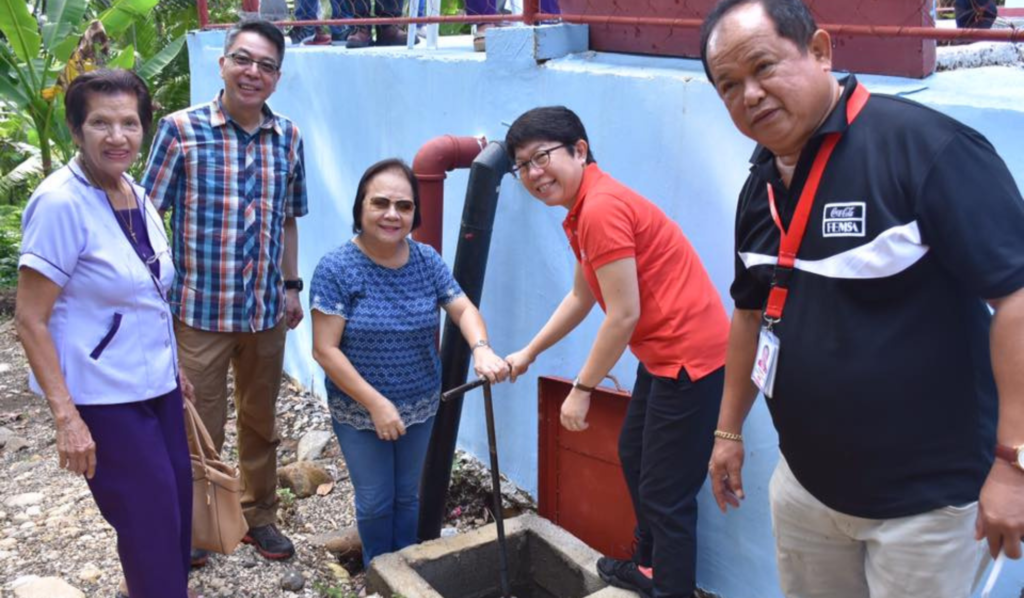
Community unites for safe and affordable drinking water
Access to safe drinking water is one of the daunting challenges facing marginalized communities in both rural and urban Philippines.
This situation is made more ironic in Cagwait, Surigao Del Sur, which once had a thriving forest and boasts of abundant freshwater sources that feed into the scenic Cagwait beach, known as the “Boracay of Caraga”[2] and host to the annual Kaliguan festival.
Cagwait’s forests are all but gone today and potable water has become difficult to come by. To address the residents’ growing need for safe and affordable drinking water, the Aras-asan/Unidad Waterworks and Sanitation Association (AURWSA) was established.
Before this, the community was getting its water from a private distributor that however mismanaged the business and racked up unpaid loans with the government’s Local Water Utilities Administration (LWUA).
To prevent a disruption of the water service, members of AURWSA asked to take over management of the water distribution. A lengthy litigation process followed, but the association eventually took control of the distribution system.
One of the first items in the new management’s agenda was to have water delivered directly to households.
Rizalina Cagape, who served as cashier for both the former management and AURWSA, said that very few consumers had faucets inside their homes (level 3) during the time of the private distributor. Most households got their water from outdoor faucets located in strategic areas in the community (level 1).
“Converting to level-3 water distribution became a priority of the new management,” Cagape said.
AURWSA was able to accomplish this through a PhP750,000 loan facilitated by parish priest Fr. Teodomero Acero.
But as its subscriber base grew, and dry spells were affecting water supply, AURWSA had to make new plans for the dry months.
“We were sourcing our water from a spring and two reservoirs. During the dry season, these sources would see a major drop in discharge. We needed to build new reservoirs,” said Remiberto Andoy, AURWSA chairperson.
To start off the project, AURWSA took out a PhP2.17-million loan from the Peace and Equity Foundation (PEF) in 2016. It also received a PhP2.18-million grant from the Coca-Cola Foundation Philippines Inc. via its Agos-Scaling Up Project for Social Enterprises for Water Services.
With these funds, AURWSA launched its Rehabilitation and Expansion of Water System project. The Coca-Cola grant was spent to construct a mini-dam while the PEF loan covered piping and distribution costs.
Besides opening a new water source, the project also aimed to add a third barangay (village) to its service area. In the beginning, AURWSA was distributing water only to two barangays, Aras-asan and Unidad. The new project targeted the addition of a third, Tubo-Tubo.
The mini-dam was built at Camuning Creek, in Barangay Tubo-Tubo, around four kilometers from Barangay Aras-asan center. Project implementation started in February 2017 and completed in August of the same year.
Now AURWSA could reliably distribute water from two of its existing reservoirs – Aras-asan Timber Company and Barangay Waterworks Association – and install a secondary distribution line to Barangay Tubo-Tubo, thereby increasing the number of customers covered.
“We used to get our drinking water from faucets along the road,” said Pamela Vasquez, resident of Barangay Tubo-Tubo. “We walked a half-kilometer to take a bath and do our laundry in the creek. Now, it is more convenient. We can have our meals on time because we do not need to get water from so far away.”
Having water that is safe to drink is important to residents because water-borne diseases are common in the locality.
The local government in Cagwait also runs a water distribution service. But only AURWSA’s water passed a bacteriological and physical chemical examination at the San Francisco Water District Laboratory in Agusan del Sur.
As a result, many businesses needing safe water for their operations, including restaurants, bakeries, mini-groceries and water refilling stations, have subscribed to AURWSA’s services.
Among its clients are six water refilling stations, not a small feat considering the size of the municipality. These are Pepino Purified Drinking Water, Leopoldo’s Refilling Station, RJ Refilling Station, JIS Refilling Station, Limshe Refilling Station, and Bantugan’s Refilling Station.
Evangeline Montemayor, resident of Purok San Francisco, Aras-asan, said that since getting her water from AURWSA, she and her family no longer got skin allergies.
The association now counts 1,140 customers from about 100 members when it started. With sound financial management, it has been able to fully pay its PEF loan in March 2021.
Like most businesses, AURWSA was affected by the unprecedented COVID-19 pandemic. “We could not collect from households with positive cases so we had a backlog in collection. But our operations were not as affected as the other enterprises,” said Chairperson Andoy, who also doubles as AURWSA’s head of maintenance.
The association recognizes that more challenges lie ahead. It covers only three of Cagwait’s 11 barangays[3]. And while it has over 1,000 subscribers now, Cagwait has a population of over 21,747[4].
“We still have a lot to do to provide safe drinking water to more of our townmates. We have more initiatives in the pipeline and hope that more partners like PEF and Coca-Cola Foundation continue to support us in our endeavors,” said Sarah Urbiztondo, AURWSA board member and Secretary.
[2] Caraga, officially the Caraga Administrative Region and designated as Region XIII, is an administrative region in the Philippines occupying the northeastern section of Mindanao. It is composed of five provinces: Agusan del Norte, Agusan del Sur, Dinagat Islands, Surigao del Norte, and Surigao del Sur.
[3] PhilAtlas (https://www.philatlas.com/mindanao/caraga/surigao-del-sur/cagwait.html)
[4] Ibid.